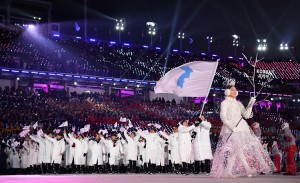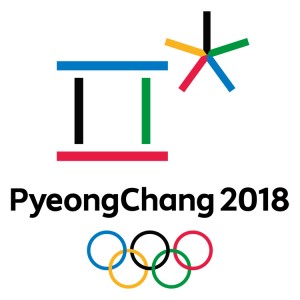Olympic February: Grand Openings
February 15, 2018
Last Friday, February 9, the Winter Olympic Games opened in the town of Pyeongchang (sometimes written as PyeongChang) in northeastern South Korea. Pyeongchang sits among the Taebaek Mountains of Gangwon Province southeast of Seoul, the South Korean capital. The first week of the Winter Olympic Games saw outstanding performances on the ice and snow, but perhaps the most dramatic event occurred during the opening ceremonies when the North and South Korean teams marched together under a flag representing a unified Korea. The two nations, created in 1948, were embittered by the brutal Korean War (1950-1953), and they have been at odds ever since.

The North Korea and South Korea Olympic teams march together under the Korean Unification Flag during the opening ceremony of the Winter Olympic Games at Pyeongchang Olympic Stadium on Feb. 9, 2018. Credit: © Matthias Hangst, Getty Images
At Pyeongchang Olympic Stadium, ornate performances and light shows punctuated international team arrivals, but the most dazzling—and historical—moment was when members of the North and South Korean teams marched into the stadium side-by-side. In the stands, South Korean president Moon Jae-in shook hands with Kim Yo-jong, the sister of North Korean dictator Kim Jong-un. Kim Yo-jong’s visit to South Korea is the first by a member of the North Korean ruling family since Kim Il-sung established North Korea as a Communist state in 1948. A combined North and South Korean women’s hockey team later competed in the games, but all other Korean athletes competed under their nation’s individual flag.

In the official Olympic emblem, the symbol ㅍ represents the first consonant of the first syllable of Pyeongchang in the Korean alphabet, (known as Hangeul), and expresses the “harmony of heaven, Earth, and man.” ㅊ depicts the first consonant of the second syllable of Pyeongchang, and represents “snow, ice, and winter sports stars (athletes).” Credit: © Olympic Winter Games PyeongChang 2018
On the snow and ice, athletes from Norway, Canada, the Netherlands, and Germany jumped out to early medals in such cold-weather competitions as cross-country skiing, curling, speed skating, and ski jumping. United States snowboarders dominated as Redmond Gerard, Jamie Anderson, rising star Chloe Kim, and veteran boarder Shaun White won the first U.S. gold medals. U.S. alpine skier Mikaela Shiffrin added a gold in the ladies’ giant slalom. Chris Mazder became the first U.S. athlete to medal in the luge, winning a surprising silver behind Austria’s David Gleirscher. In the team figure skating competition, the U.S. won bronze as Mirai Nagasu became the first American woman to land a triple axel jump (3 1/2 spins in mid-air) at the Olympics. The feat was accomplished previously by Japanese Olympians Midori Ito and Mao Asada. (Nagasu’s parents are also from Japan.) Canada won gold in the figure skating team competition, and the Olympic Athletes from Russia (OAR) took silver. The International Olympic Committee banned Russia from competing as a team because of performance-enhancing drug use, but individual Russian athletes—cleared by drug tests—have been allowed to compete under the OAR banner.
High winds delayed or postponed many events, but the weather calmed to allow Austrian skiing great Marcel Hirscher to win a long-awaited first Olympic gold medal. Skiers from France and Sweden also picked up gold medals in the first week, and short-track speed skater Lim Hyo-jun earned the host country’s first gold medal.


